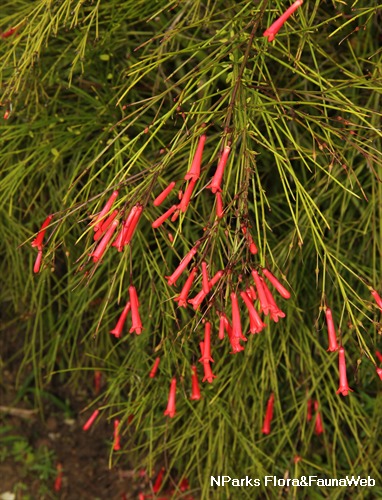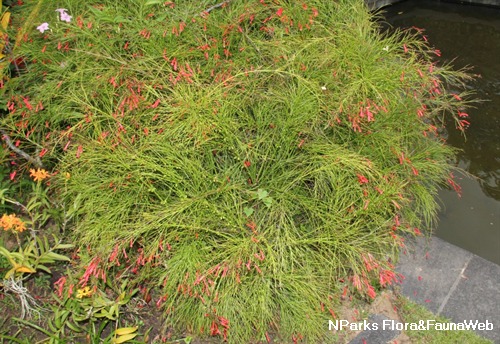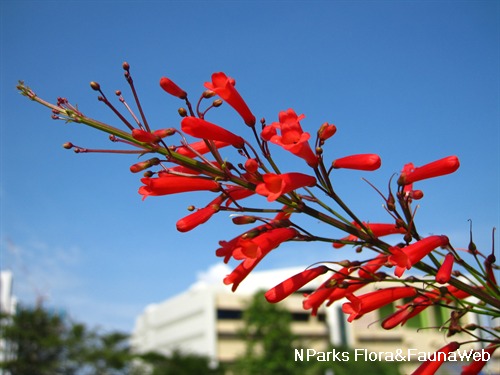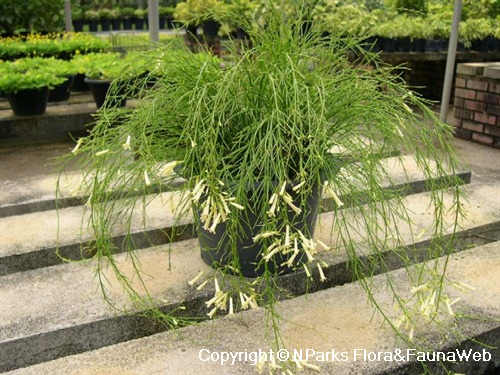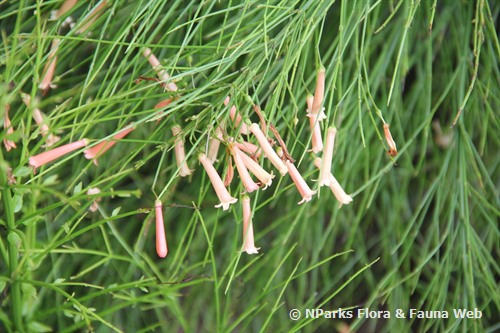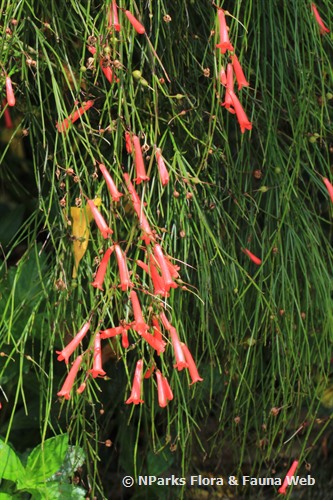
Back
Russelia equisetiformis
| Family Name: | Scrophulariaceae |
| Synonyms: | Russelia juncea |
| Common Name: | Coral Plant, Fountain Plant, Firecracker Plant, Fountain Bush |
Name
Classifications and Characteristics
| Plant Division | Angiosperms (Flowering Seed Plants) |
|---|---|
| Plant Growth Form | Shrub |
| Mode of Nutrition | Autotrophic |
Biogeography
| Native Distribution | Mexico |
|---|---|
| Native Habitat | Terrestrial |
| Preferred Climate Zone | Tropical |
| Local Conservation Status | Non-native |
Description and Ethnobotany
| Growth Form | Multi-branched subshrub, able to grow up to about 1 - 1.5 m tall and with a spread of 2 - 4 m wide. |
|---|---|
| Foliage | Leaves are reduced to small scale-like leaflets, bright green, ovate to elliptic, measuring about 8.5 - 15 mm long by 6 - 9 mm wide. |
| Stems | Branches start out erect and bend over as they grow longer, giving it a weeping form. |
| Flowers | Slender, bright red, tubular flowers measuring about 2.5 cm long, borne on the tip of branches resembling firecrackers, usually in 1 - 3 flowered clusters. |
| Fruit | Fruit is dry, brown capsule, oval or globose in shape and measuring about 3 - 6 mm wide. Seeds are small, light brown and oval in shape. |
| Etymology | Genus Russelia is named after Dr Alexander Russell (1715 - 1768), a Scottish naturalist and author of Natural History of Aleppo russellianus. Species equisetiformis refers to the plant having a horsetail like habit. |
Landscaping Features
| Desirable Plant Features | Ornamental Flowers |
|---|---|
| Landscape Uses | Suitable for Hanging Baskets, Parks & Gardens, Small Gardens |
Fauna, Pollination and Dispersal
| Fauna Pollination Dispersal Associated Fauna | Butterfly-Attracting |
|---|---|
| Pollination Method(s) | Biotic (Fauna) |
Plant Care and Propagation
| Light Preference | Full Sun |
|---|---|
| Water Preference | Little Water |
| Plant Growth Rate | Fast |
| Rootzone Tolerance | Moist Soils, Well-Drained Soils |
| Propagation Method | Stem Cutting |
Foliar
| Foliage Retention | Evergreen |
|---|---|
| Mature Foliage Colour(s) | Green |
| Foliar Modification | Scale-like |
| Foliar Arrangement Along Stem | Opposite |
| Foliar Attachment to Stem | Sessile |
| Leaf Area Index (LAI) for Green Plot Ratio | 4.5 (Shrub & Groundcover - Dicot) |
Floral (Angiosperm)
| Flower Colour(s) | Red |
|---|---|
| Flower Grouping | Cluster / Inflorescence |
Image Repository
Others
| Master ID | 1113 |
|---|---|
| Species ID | 2406 |
| Flora Disclaimer | The information in this website has been compiled from reliable sources, such as reference works on medicinal plants. It is not a substitute for medical advice or treatment and NParks does not purport to provide any medical advice. Readers should always consult his/her physician before using or consuming a plant for medicinal purposes. |

